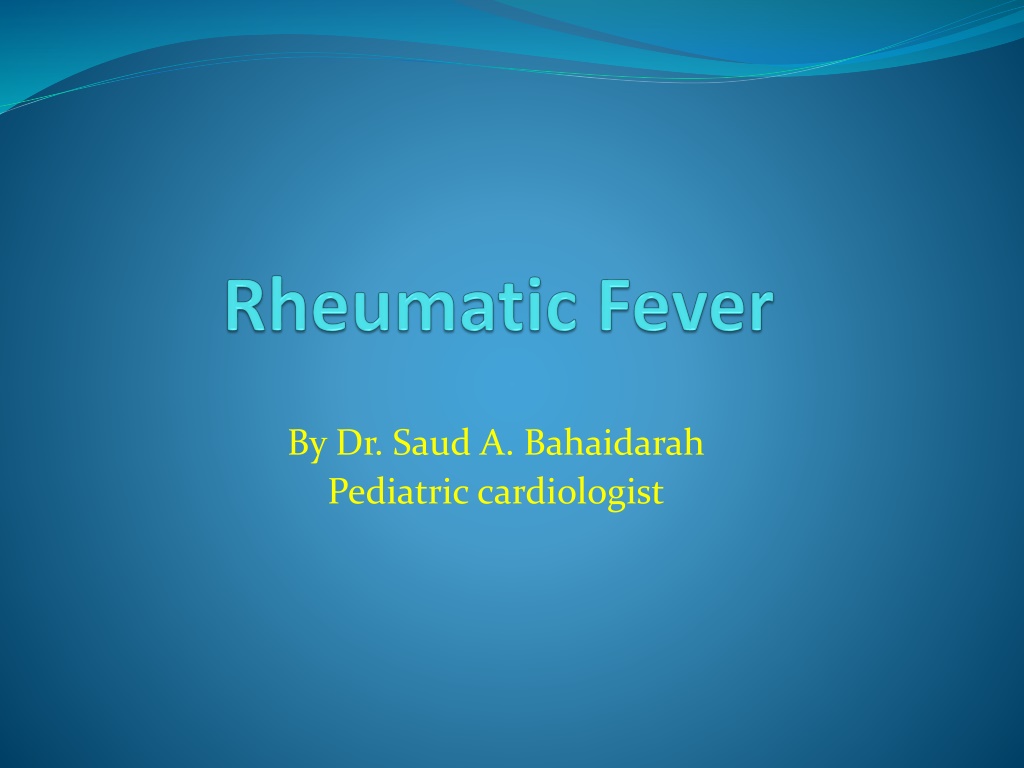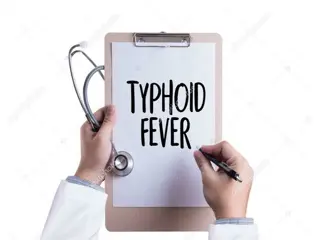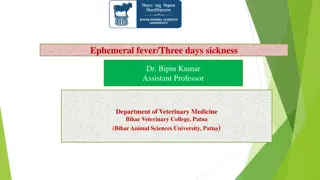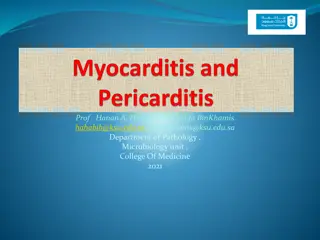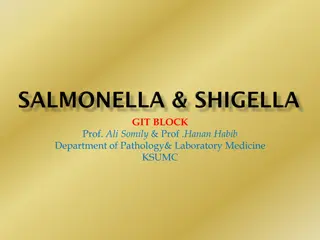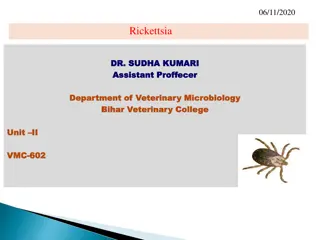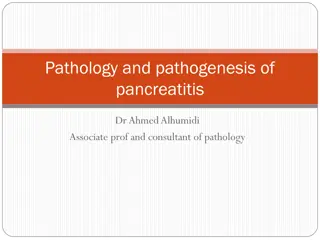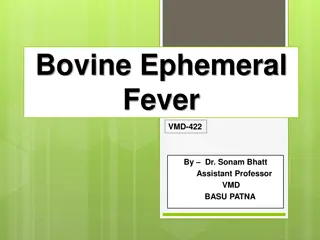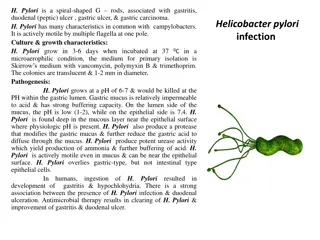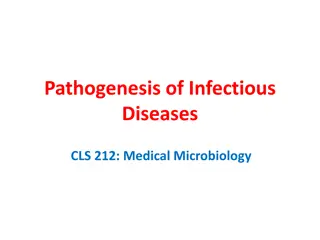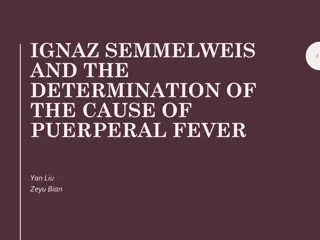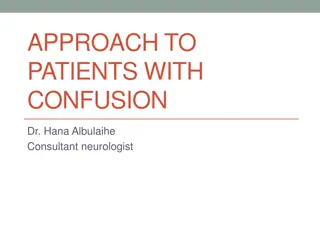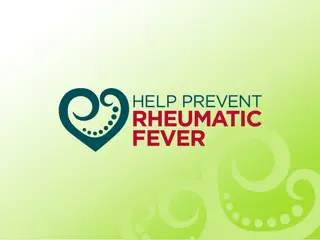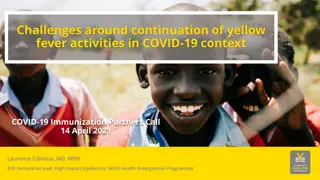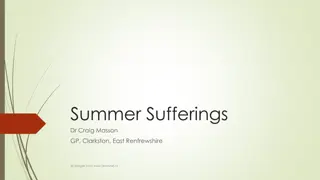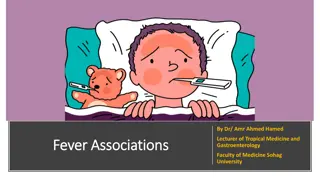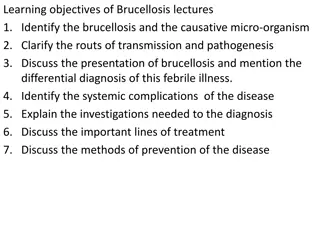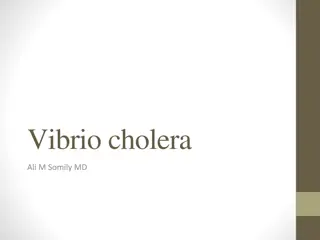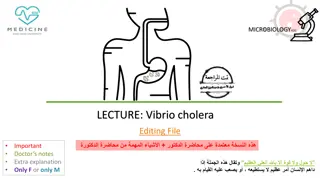Rheumatic Fever: A Comprehensive Overview of Epidemiology, Pathogenesis, and Clinical Features
Rheumatic fever is a delayed autoimmune reaction to group A, B-hemolytic streptococcal pharyngitis in genetically susceptible individuals. This condition involves the heart, joints, brain, skin, and serous surfaces. The incidence varies between developing and developed countries, with environmental factors such as overcrowding, poverty, and poor access to healthcare contributing to its prevalence. The pathogenesis involves Group A, B hemolytic streptococcus, leading to activation of T-cells and B-cells that attack the heart. Host factors like age and genetic predisposition play a role in susceptibility to rheumatic fever.
Download Presentation

Please find below an Image/Link to download the presentation.
The content on the website is provided AS IS for your information and personal use only. It may not be sold, licensed, or shared on other websites without obtaining consent from the author. Download presentation by click this link. If you encounter any issues during the download, it is possible that the publisher has removed the file from their server.
E N D
Presentation Transcript
By Dr. Saud A. Bahaidarah Pediatric cardiologist
Definition Delayed autoimmune reaction to group A, B-hemolytic streptococcal pharyngitis in genetically susceptible individuals . Involves : heart, joints, brain, skin, serous surfaces
Epidemiology Prevalence developed countries , RF was decreasing science 1920 s and almost disappeared in 1980 s , and reappear again in 1985 due to reappearance of streptococcus with M- protein serotype. In developing countries , RF is a major problem affecting about 10-20 million per year, RHD is a primary cause of death below 50 years of age
Incidence: In developing countries : 150 per 100,000 with mortality rate up to 8.2 per 100,000 from cardiac involvement In developed countries : less than 1 per 100,000 with mortality rate of 1.8 per 100,000
Environment : overcrowding, poverty, poor nutrition, poor hygiene, and poor access to health care are common in developing countries and contribute to rapid spread (respiratory droplets) and increased virulence of GAS . With poor access to health care, GAS pharyngitis is less likely to be diagnosed and treated, precluding effective primary prevention of RF Both GAS pharyngitisand RF are more common during the winter and spring in temperate climates, but there is no consistent seasonal pattern in the tropics
Host : Age : 5-15 years of age with peak at 8 years Uncommon before 5 years and after 35 years of age Almost never before 2 years of life No gender predisposition except for chorea in girls Recurrence in adolescent and early adulthood Family history indicates genetic factor which still under study
Pathogenesis Organism : group A, B hemolytic streptococcus Serotype : depends on M-protein : Class I : infect pharynx causing RF Class II : infect skin causing glomerulonephritis Latent period : 10 days to 5 wk, average of 18 days Infection lead to activation of T-cells and B-cell and release of cytokines and antibodies which will attack the myosin the heart .
Pathology Aschoff nodules : perivascularaggregation characterized by a central area of fibrinoid change (altered collagen) surrounded by or infiltrated by large multinucleated cells Found in all affected organs i.e. heart, skin, brain, joint, serous surfaces.
Clinical picture History of sore throat about 3wk back History of fever with other major or minor manifestation
Arthritis Common in 70% of RF cases Migratory, non destructive arthritis Involves large joints with all signs of inflammation mostly knees ,hips, ankles, elbows, wrist, shoulder Duration not more than 2-3 days Self limited Respond dramatically to salisylate
Carditis About 50% of RF will be affected Ranges from asymptomatic , heart murmur to sever heart failure Usually it is pancarditis Affecting mitral valve 95% , aortic valve 25% , tricuspid valve and rarely pulmonary valve Pericarditis in 4-10%
Sydenham's chorea In 10-30 % of patient with RF Due to inflammation in the basal ganglia, cerebral cortex, and the cerebellum Involuntary, purposeless movements, muscular incoordination and/or weakness, and emotional lability tongue movements described as resembling a bag of worms Explosive speech pronation of the hands when arms are extended above the head (pronatorsign), irregular contractions of the hands when asked to squeeze an object (milkmaid's grip) hyperextension of the fingers when hands are extended forward with eyes closed, (spooning)
Patients often come to attention based on deterioration in school performance, and neurobehavioral symptoms seen along with the chorea including irritability, poor attention span, lack of cooperation, and obsessive-compulsive symptoms are not uncommon. Sensory deficits do not occur. The neurologic manifestations are usually bilateral but may be unilateral (hemichorea). These symptoms, which decrease with rest and sedation and increase with effort or excitement Resolve over a median of 15 weeks, and by 6 months in 75% of cases . Recurrent episodes of chorea are not uncommon
Latent period in chorea is about 1-6 month while in arthritis 10-18 days , this can explain that both don t present together . If chorea and cardiac involvement together most likely the cardiac involvement is mild with decreased acute phase reactant
Erythema Marginatum occurs in less than 10% of patients with acute rheumatic fever. The characteristic nonpruritic serpiginous or annular erythematousrashes are most prominent on the trunk and the inner proximal portions of the extremities; they are never seen on the face. The rashes are evanescent, disappearing on exposure to cold and reappearing after a hot shower or when the patient is covered with a warm blanket. They are seldom detected in air-conditioned rooms.
Subcutaneous nodules Found in 2% to 10% of patients, particularly in cases with recurrences They are hard, painless, nonpruritic, freely movable, swelling, and 0.2 to 2 cm in diameter. They are usually found symmetrically, singly or in clusters, on the extensor surfaces of both large and small joints, over the scalp, or along the spine. They are not transient, lasting for weeks Have a significant association with carditis.
Laboratory : Increase in acute phase reactant Evidence of streptococcal infection : Positive throat swap Strep antibodies : Antistreptolysin O (ASO) titer is well standardized and therefore is the most widely used test. It is elevated in 80% of patients with acute rheumatic fever and in 20% of normal individuals. Only 67% of patients with isolated chorea have an elevated ASO. AntideoxyribonucleaseB titer The Streptozymetest
ECG : Prolongation of PR interval Occasional 2:1 block, rarely complete heart block Nonspesific T wave and ST segment changes CXR: Enlareged heart Evidence of increase PVM if CHF Echocardiography : Evaluate the effect of carditis on the heart including MR, AR, MS, preicardial effusion, and function
Diagnosis Moss and Adam s Heart Disease in Infant, Children, and Adolescents 7thedition
Treatment Includes : Bed rest Anti-inflammatory Heart failure managements Antibiotics : primary and secondary prevention
Bed rest Pediatric Cardiology for practitioners 4thedition
Anti-inflammatory Mild to moderate carditis: aspirin 80-100 mg/kg/day in 4 divided doses for children 4-8 g/day in adolescents and adults Target salicylate levels 20-30 mg/dL Don't forget to protect the stomach Severe carditis: Initial steroids (prednisone 2 mg/kg/day) for approximately 2 weeks, then taper Begin aspirin approximately 1 week prior to stopping steroids to prevent rebound Follow acute phase reactants (erythrocyte sedimentation rate, C-reactive protein)
Heart failure managements Depending on the severity Salt and water restriction Diuretics Afterload reduction Surgery in sever cases that needs intervention and refractory to medical management
Antibiotics : primary prevention To eradicate the organism Doesn't interfere with disease course Moss and Adam s Heart Disease in Infant, Children, and Adolescents 7thedition
Antibiotics : secondary prevention To prevent the recurrence and then worsening of the RHD Recurrence rate 40-60 % Higher in early years after 1stattack then decreases with time Moss and Adam s Heart Disease in Infant, Children, and Adolescents 7thedition
